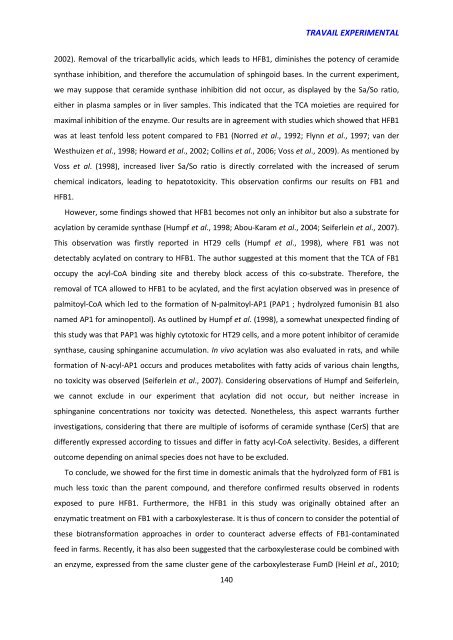Effet chez le porcelet d'une exposition à un régime co-contaminé en ...
Effet chez le porcelet d'une exposition à un régime co-contaminé en ...
Effet chez le porcelet d'une exposition à un régime co-contaminé en ...
Create successful ePaper yourself
Turn your PDF publications into a flip-book with our unique Google optimized e-Paper software.
TRAVAIL EXPERIMENTAL2002). Removal of the tricarballylic acids, which <strong>le</strong>ads to HFB1, diminishes the pot<strong>en</strong>cy of ceramidesynthase inhibition, and therefore the accumulation of sphingoid bases. In the curr<strong>en</strong>t experim<strong>en</strong>t,we may suppose that ceramide synthase inhibition did not occur, as displayed by the Sa/So ratio,either in plasma samp<strong>le</strong>s or in liver samp<strong>le</strong>s. This indicated that the TCA moieties are required formaximal inhibition of the <strong>en</strong>zyme. Our results are in agreem<strong>en</strong>t with studies which showed that HFB1was at <strong>le</strong>ast t<strong>en</strong>fold <strong>le</strong>ss pot<strong>en</strong>t <strong>co</strong>mpared to FB1 (Norred et al., 1992; Flynn et al., 1997; van derWesthuiz<strong>en</strong> et al., 1998; Howard et al., 2002; Collins et al., 2006; Voss et al., 2009). As m<strong>en</strong>tioned byVoss et al. (1998), increased liver Sa/So ratio is directly <strong>co</strong>rrelated with the increased of serumchemical indicators, <strong>le</strong>ading to hepatotoxicity. This observation <strong>co</strong>nfirms our results on FB1 andHFB1.However, some findings showed that HFB1 be<strong>co</strong>mes not only an inhibitor but also a substrate foracylation by ceramide synthase (Humpf et al., 1998; Abou-Karam et al., 2004; Seifer<strong>le</strong>in et al., 2007).This observation was firstly reported in HT29 cells (Humpf et al., 1998), where FB1 was notdetectably acylated on <strong>co</strong>ntrary to HFB1. The author suggested at this mom<strong>en</strong>t that the TCA of FB1occupy the acyl-CoA binding site and thereby block access of this <strong>co</strong>-substrate. Therefore, theremoval of TCA allowed to HFB1 to be acylated, and the first acylation observed was in pres<strong>en</strong>ce ofpalmitoyl-CoA which <strong>le</strong>d to the formation of N-palmitoyl-AP1 (PAP1 ; hydrolyzed fumonisin B1 alsonamed AP1 for aminop<strong>en</strong>tol). As outlined by Humpf et al. (1998), a somewhat <strong>un</strong>expected finding ofthis study was that PAP1 was highly cytotoxic for HT29 cells, and a more pot<strong>en</strong>t inhibitor of ceramidesynthase, causing sphinganine accumulation. In vivo acylation was also evaluated in rats, and whi<strong>le</strong>formation of N-acyl-AP1 occurs and produces metabolites with fatty acids of various chain <strong>le</strong>ngths,no toxicity was observed (Seifer<strong>le</strong>in et al., 2007). Considering observations of Humpf and Seifer<strong>le</strong>in,we cannot exclude in our experim<strong>en</strong>t that acylation did not occur, but neither increase insphinganine <strong>co</strong>nc<strong>en</strong>trations nor toxicity was detected. Nonethe<strong>le</strong>ss, this aspect warrants furtherinvestigations, <strong>co</strong>nsidering that there are multip<strong>le</strong> of isoforms of ceramide synthase (CerS) that arediffer<strong>en</strong>tly expressed ac<strong>co</strong>rding to tissues and differ in fatty acyl-CoA se<strong>le</strong>ctivity. Besides, a differ<strong>en</strong>tout<strong>co</strong>me dep<strong>en</strong>ding on animal species does not have to be excluded.To <strong>co</strong>nclude, we showed for the first time in domestic animals that the hydrolyzed form of FB1 ismuch <strong>le</strong>ss toxic than the par<strong>en</strong>t <strong>co</strong>mpo<strong>un</strong>d, and therefore <strong>co</strong>nfirmed results observed in rod<strong>en</strong>tsexposed to pure HFB1. Furthermore, the HFB1 in this study was originally obtained after an<strong>en</strong>zymatic treatm<strong>en</strong>t on FB1 with a carboxy<strong>le</strong>sterase. It is thus of <strong>co</strong>ncern to <strong>co</strong>nsider the pot<strong>en</strong>tial ofthese biotransformation approaches in order to <strong>co</strong><strong>un</strong>teract adverse effects of FB1-<strong>co</strong>ntaminatedfeed in farms. Rec<strong>en</strong>tly, it has also be<strong>en</strong> suggested that the carboxy<strong>le</strong>sterase <strong>co</strong>uld be <strong>co</strong>mbined withan <strong>en</strong>zyme, expressed from the same cluster g<strong>en</strong>e of the carboxy<strong>le</strong>sterase FumD (Heinl et al., 2010;140

















